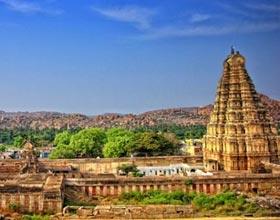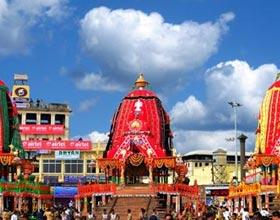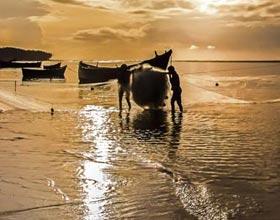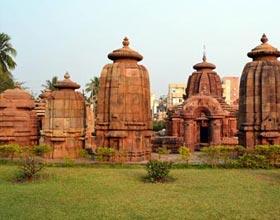Orissa / Odisha Tour Packages
Tropical Orissa has much to offer the traveller. Temples abound, notably the Sun Temple at Konark; pilgrims flock to the seaside city of Puri; elephants and tigers inhabit the wildlife parks
Most visitors to Odisha seek out Adivasi villages, ancient temples, or wide beaches with migrant turtles, although the state is also known for its dancers and sudden cyclones. In 1999 a huge cyclone hit the state, killing thousands of people and destroying many buildings. Ancient seafarers from Orissa set up colonies in Burma and Java. Buddhism became the religion of the kingdom of Kalinga, as Orissa was called, soon after the faith was established. Buddhist universities flourished at Nrusinghanath and Ratnagiri, near Cuttack.
Orissa is an intensely religious state where devotion is focused on Lord Jagannath, an incarnation of Visnu. Not surprisingly, many elements of Orissan culture stemmed from its temples, where the most remarkable erotic statuary can be found and where Odissi originated, a style of religious dance. Odissi was performed previously in temples by resident dancers (maharis) devoting their lives to the temple god. When temple dance was outlawed the style began to disappear, however, Odissi has been revived as a performing art.
Bhubaneshwar: City of Temples
Capital of Odisha only since 1956, Bhuhaneshwar, is a city of temples. There were once more than 1,000 of them and many are still active. A large number of temples are located around Bindu Sarovar, a tank that is believed to receive water from all the holy rivers of India. The Lingaraj Temple to the south, built in 1014 AD to the glory of Siva, is certainly the most impressive. A massive wall surrounds a 45-metre (150-ft) high deul (temple), as well as minor temples to Parvati, Gopalini and Bhubaneshwari. All are decorated with a profusion of sculptures of deities, nymphs and -amorous couples. Entry is prohibited to non-Hindus.
Vaital Deul is a typical 8th-century temple with an oblong roof (khakhara deul). It is decorated with stone figures of Durga, such as the eight-armed Mahish-asuramardini, on the northern wall, piercing the left shoulder of Mahishasura, the buffalo-headed demon, with her trident. Within the sanctum, another avatar (incarnation) of Durga, eight-armed Chamunda, often hidden by a drape, sits on a corpse, with an owl and a jackal on each side. She wears a garland of skulls.
Sisiresvara Temple, next to Vaital, has sculptures of lions, elephants, the gods Ganesh and Kartikeya, and the Avilokiteshwara Buddha seated cross-legged and accompanied by a deer and a nag (cobra), showing how strong Buddhist influence was in Orissa. The Uttaresvara Temple on the north bank of the lake has undergone extensive restoration.
Parasuramesvar is one of the oldest of a group of temples east of the lake. Built in the 7th century, it is still well preserved and is decorated with a four-Armed Ganesh, a two-armed Kartikeya mounted on a peacock and killing a snake, amorous couples and rampant lions. Muktesvara is the gem of Orissan architecture. the temple compound is through a sculptured torana ( gateway); the jagamohana (porch) has diamond-shaped latticed windows and a richly decorated interior. Temple, gateway and walls are covered with figures of female warriors, erotic scenes elephants, women, monkeys in various comic scenes, women worshippinglig lingas and naginis (half-snakes, half-women). On each side of the deul is a grimacing lion face, flanked by smiling ganas (dwarfs).
Bhubaneshwar has two museums worth visiting. The Orissa State Museum (open loam-5pm, closed Mon) displays Hindu, Buddhist and Jain sculptures and early Orissan palm manuscripts. The Handicrafts Museum has a collection of traditional art, including Cuttack silver filigree. The Tribal Research Museum (open 10am-5pm, closed Sun) is in a cluttered government office, and has a decent bookshop of manuscripts and maps.
Around Bhubaneshwar
West of Bhubaneshwar, on the immediate outskirts, is two hills, Udayagiri and Khandagiri. Both were once inhabited by Jain ascetics who lived in cells excavated in the rock. Khandagiri has fewer caves than Udayagiri but a small Jain temple still stands on top of this hill.
At Dhauli, a hill 8 km (5 miles) south of Bhubaneshwar, there is an example of Emperor Ashoka's edicts. Sculpted elephants mark the site where in 262 BC the Mauryan emperor Ashoka defeated Kalinga troops, slaying 100,000 people and taking 150,000 captive. This scene of bloodshed is said to have turned Ashoka away from violence and led him to adopt Buddhism. To commemorate Ashoka's acceptance of Buddhism, substituting the ideal of dharmavijaya, spiritual victory, for digvijaya, military conquest, Japanese Buddhists have built a white Peace Pagoda on top of the hill. Some 10 km (6 miles) south is Pipli, a small village specialising in appliqué work in vivid colours unique to this area.
Purl 2, 60 km (37 miles) southeast of Bhubaneshwar, is the holiest place in Orissa for Hindus, and one of the biggest pilgrimage centres in India. The city was once a flourishing port identified with ancient Dantpur.
Puri is known for its cult of Jagannath, originating some say in the times when the people of Orissa worshipped trees and hence the practice of caning 54 his image in wood. According to the more popular legend. However, the Lord appeared in King Indrodyumna's dream and commanded him to build a temple for him. The king complied, having the images caned out of a single log of wood found floating in the sea, as the Lord had enjoined in the dream. The climax of Jagannath worship is the Rath Yatra festival celebrated every summer summer at the Jagannath Temple.
Although the beach at Puri is one of the best in India. the seas can be very rough, with strong and erratic currents. Caution is advised. Noha, lifeguards. easily recognisable by their white cone-shaped straw huts, are not always alert. Be sure to watch the fishermen come ashore through the surf.
The Sun Temple
Going north, 33 km (20 miles) from Puri, is Konark (Konarak) 3, a former centre of Orissan Buddhism, an active port. now silted and, in ancient times, a centre for sun worship. A temple to the Sun God was built in the 9th century. The Present Sun Temple was erected in the 13th century. It took 16 years to complete:1,200 artisans were employed on the task. In its original form the temple consisted of a 70-metre (230-ft) high deul with a 40-metre (130-ft) jagamohana, representing the Chariot of the Sun, drawn by seven impetuous horses, the chariot rode on a dozen pairs of eight-spoke wheels. The deul collapsed in the middle of the 19th century and one horse is missing.The temple no longer stands on the shore since the sea has receded 3 km (2 miles). Despite its dilapidated state the Sun Temple stands out as a fine example of Orissan architecture Erotic sculptures of couples in sensuous contortions, depictions of nymphs, war, hunting and court scenes, musicians, floral motifs, and elephants are carved on the ruins.
South along the coast
South of Bhubaneshwar, along the coast, is Chilka Lake, a 1,100-sq. km (425-sq. mile) shallow inland sea, separated from the Bay of Bengal by a sandy ridge, spreading over 75 km (47 miles) from north to south. From Barkul, the Orissa Tourist Development Corporation operates a two-hour cruise to Kalijai Temple offshore, and to Nalabar Island The lake has an abundance of fish and shellfish. From mid-December to mid-January migratory birds spend the winter here. Further south, 95 km (59 miles) from Bhubaneshwar, Gopalpur-on-Sea 4 was, before the cyclones of late-1999, one of the finest beach resorts in Eastern India.
Adivasis live in the district of Koraput, the Southern Hills area. Most are from the Austro-Asiatic Munda group, and the Bondas are the least acculturated. Women marry boys half their age and the men, armed with arrows, get drunk on sago palm toddy. They dress mostly in beads, though the women wear a stack of nine metal rings around their necks. Market day is the best time to spot them.
In the Northern Hills bordering West Bengal and Bihar, Simlipal National park 5 is one of India's most attractive forests, its 2,750 sq km (1,062 sq miles) arc populated with tigers and wild elephants.
Northern Orissa
About 15 km (10 miles) north from Bhubaneshwar is Nandanakanan, a park set in the Chandka Forest, where animals are kept in natural surroundings. The main attractions are four white tigers, one-horned rhinos, white-browed gibbons and African lions. There is also a Botanical Garden, with a rosarium, Zen temple and a cactus house.
Cuttack , the former capital of Orissa, is situated on a narrow river island 19 km (12 miles) north of Bhubaneshwar. There are a few histoncal remains, including the blue granite Barabati Maratha fort, stormed by the British in 1803; Qadam-i-Rasal, a walled compound with corner towers, containing three 18th century mosques and a domed building housing footprints of Prophet Muhammad engraved on a circular stone. The shrine is visited by both Muslim and Hindu worshippers.
Further north, Balasore , is one of the earliest British settlements in India, granted to the East India Company in 1633. Nearby are three shrines. The Kutopokhari Temple at Remuna, is a seat of Vaishnava culture and has an 18-arm granite statue of Durga. Bhudhara Chandi at Sajanagarh, built in the 16th century, contains a three-faced image of Shakti. Panchalingeswar on Devagiri Hill, is a temple with five stone lingarns. To the east is the small resort of Chandipur-on-Sea 8, with a beach where the sea recedes by 5 km (3 miles) at low ride. Fish-ermen will take visitors out in their catamarans.





















